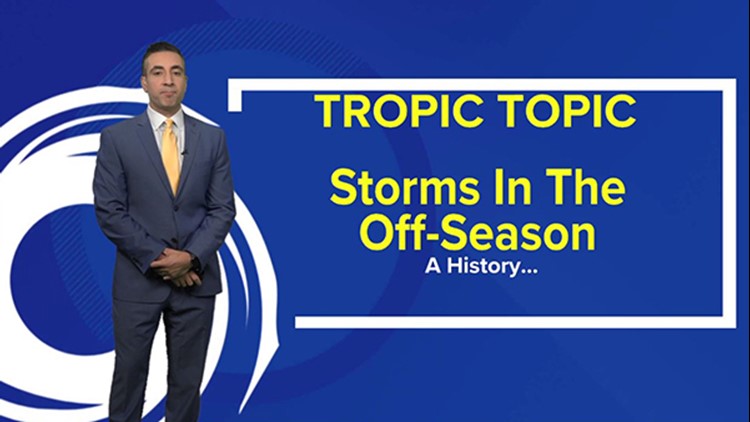HOUSTON — The clock is ticking down to the start of yet another hurricane season. Beginning June 1 and not ending for 6 months until November 30th. But Mother Nature doesn’t really follow a calendar and as a result, when the conditions are right, tropical storms and hurricanes can form outside of the "normal" season.
There’s reasoning to why there’s a designated hurricane season and that’s because 97% of all named storms form during this 6 month window . This happens because the atmospheric and ocean conditions are the most ideal. An abundance of warm ocean water, (80°F or warmer), moist air, seeds of energy ejecting into the Atlantic off the African coast and favorable upper-level winds which are influenced by the ENSO phase. But sometimes these conditions will persist long after the season has ended or become favorable well before the season begins.
Records of tropical systems go back to 1851, of the off-season months, which do you think is the quietest in terms of tropical activity? January, February, March, April, May, or December? Let’s find out.
Even though it may be the middle of winter at this point, we’ve seen named tropical systems in the Atlantic during the month of January. The last time this occurred was in 2016 with the formation of Alex, which became a category 1 storm, the strongest hurricane ever recorded in the month of January.
Any other January storms? Well yes, but we have to travel back decades to find it: 1938. A hurricane known as #1 formed in the Atlantic. Why a number and no name? Well, tropical storms and hurricanes weren’t given names until 1953 in the Atlantic and at that time it was just female names, it wasn’t until 1979 that both male and female names began being used in the basin in a rotating 6-year list. Back to the storms…there was also a tropical storm in 1951 and a subtropical storm in 1978.
Now on to February, really the heart of deep cold over much of the Northern Hemisphere at this point in our seasonal cycle. Surely this month is pretty quiet... and yes, it is, but still over that 170 years a few tropical systems did manage to form in February.
No hurricanes have ever formed in this month, however, there has been 1 tropical storm in 1952 and this one tracked right along the US southeast coastline. They called this one the Groundhog Day Storm! There was also a tropical depression in 1911.
Now of those six possible answers to the question I posed earlier, which amongst the offseason months is most quiet, March is the correct answer. Only one storm since 1851 has been recorded during the month but that storm was a doozy: a category 2 hurricane in the year 1908 that became known as the strongest off-season storm on record.
As we’re heading into spring, ocean temperatures are warming, the Northern Hemisphere is now past the Vernal Equinox, days are longer, and more heat energy is available in the oceans for potential storms. April as you’d expect starts to see an uptick in activity despite it being technically “off-season”.
There have been seven recorded storms in April since 1851. A few of them have occurred rather recently. In April of 2017, we had our first named storm of the year, Arlene, which maxed out as a weak tropical storm. In 2003 we saw Ana develop and become a tropical storm. No hurricanes have been recorded in April, though.
The month before the season officially starts sees a huge jump in activity: 55 storms have been recorded in May! In fact, each year since 2018 we’ve recorded a named tropical system during the month. Last year, Ana kicked off the 2021 list forming on May 22 becoming a tropical storm. The start of the most active year on record, 2020 began with Arthur on May 16 which became a tropical storm.
Out of 55 storms, only six went on to become hurricanes and none of those occurred this century.
Now let’s head to the other side of the season, the back end, December, coming down off of months of higher sun angles cooking up the Atlantic waters, activity drops off markedly, only 12 storms formed in December since records began in 1851. Most recently was 2013, an unnamed subtropical storm. Five storms became hurricanes.
Here are some really interesting facts from the official Atlantic hurricane database. The first storm to occur out of season was in 1865. The year with the most offseason storms was 1887 with a total of five. In seven seasons there were both storms before and after the season.
Out of all of those storms that occurred out of season, how many made landfall? Now I will say that most do NOT make landfall, good news. Most recently was Tropical Storm Bertha, which came ashore in 2020 near Isle of Palms, South Carolina – and in 2012, Tropical Storm Beryl made landfall near Jacksonville, Florida.
As we head into another season there are already seasonal outlooks that point towards above average activity in the basin. This is based off of background conditions that will be favorable for development, most notably a continuation of La Nina conditions, for the 3rd season in a row. La Nina conditions reduce the level of wind shear in the Atlantic basin, lack of wind shear helps storms remain intact. Time will tell with how this season plays out, its important to remember that it only takes one storm.



